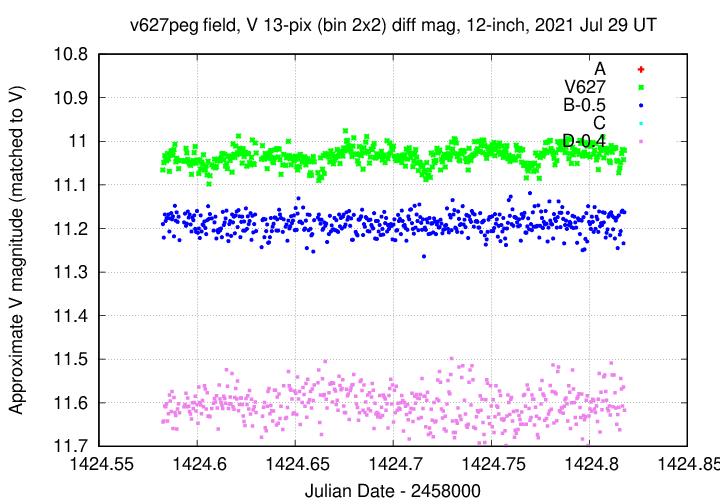
On the night of Jul 28/29, 2021, under good conditions, but with a small equipment problem, I acquired images of the cataclysmic variable star V627 Peg. One can find information about it at
The electric focus control failed this evening, so I could only focus by hand using the silver knob on the Meade LX-200 backplate. The result was a single position for the entire night, and a very large FWHM. I had to increase the size of the photometric aperture, which gives this data a lower signal-to-noise than usual.
Christian Knigge is soliciting observations of this cataclysmic variable star at all wavelengths. The AAVSO has advertised for optical measurements, and I'm joining the effort.
The main setup was:
Notes from the night:
The object is located at
RA = 21:38:06.63 Dec = +26:19:56.0 (J2000)
A chart of the field is shown below. The size of the chart is about 31 x 26 arcminutes.

I've marked the location of several comparison stars as well. See
I'll use star "D" to shift my instrumental magnitudes to the V-band scale. It has a V-band magnitude (according to AAVSO chart X26768AQ) of 12.002, and (B-V) = 0.692.
I took a photo of the finder TV's screen when pointing to this target; this could be a useful reference for the future:

The sky value shows no variation until the very end of the run, when I stopped

The FWHM graph below shows a larger the usual value, with large scatter, due to both the lack of focus control, and due to unguided 30-sec exposures.

Using aperture photometry with a radius of 13 pixels in a V filter (binned 2x2, each pixel is 1.24 arcsec, so a radius of 16 arcsec), I measured the instrumental magnitudes of a number of reference stars and the target. Following the procedures outlined by Kent Honeycutt's article on inhomogeneous ensemble photometry, I used all stars available in each image to define a reference frame, and measured each star against this frame.
Sigma-vs-mag plots show that the floor was about 0.010 mag after I removed a few images with large outliers. That's considerably worse than usual for this field.

The change in zeropoint shows quite a few outliers, due to bad tracking, mostly.

Here is the light curve of the object and several field stars in the V filter; I've shifted the instrumental magnitudes so that star "D" = 000-BJV-433 on AAVSO chart X26767AK has the value given by AAVSO as its V-band magnitude.

Here's a closeup.

I have submitted these measurements to the AAVSO, CBA, and VSNet.
You can download my measurements below. A copy of the header of the file is shown to explain the format.
# Measurements of V627Peg made at RIT Obs, UT 2021 Jul 29, # in mediocre conditions (poor focus), # by Michael Richmond, # using Meade 12-inch LX200 and ATIK 11000. # Exposures 30 seconds long, V filter. # Tabulated times are midexposure (FITS header time - half exposure length) # and accurate only to +/- 1 second (??). # 'mag' is a differential magnitude based on ensemble photometry # using a circular aperture of radius 13 pix = 16.2 arcseconds. # which has been shifted so AAVSO 000-BJV-433 has mag=12.002 # which is its V-band magnitude according to AAVSO chart X26767AK. # # UT_day JD HJD mag uncert Jul29.08257 2459424.58257 2459424.58651 11.066 0.014 Jul29.08304 2459424.58304 2459424.58698 11.049 0.014 Jul29.08352 2459424.58352 2459424.58746 11.033 0.014
Last modified 7/29/2021 by MWR.